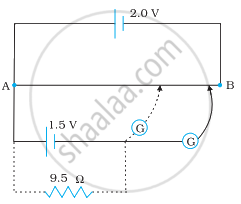Advertisements
Advertisements
Question
Figure shows a long potentiometer wire AB having a constant potential gradient. The null points for the two primary cells of emfs ε1 and ε2 connected in the manner shown are obtained at a distance of l1 = 120 cm and l2 = 300 cm from the end A. Determine (i) ε1/ε2 and (ii) position of null point for the cell ε1 only.

Solution
(i) Let x be the resistance per unit length of the potentiometer wire and I be the constant current flowing through it. Then from the figure, we have:
\[\frac{\epsilon_1 - \epsilon_2}{\epsilon_1 + \epsilon_2} = \frac{120}{300}\]
\[ \Rightarrow 180 \epsilon_1 = 420 \epsilon_2 \]
\[ \Rightarrow \frac{\epsilon_1}{\epsilon_2} = \frac{7}{3}\]
(ii) Now adding equations (1) and (2), we get:
\[2 \epsilon_1 = \left( 420x \right)I\]
\[ \Rightarrow \epsilon_1 = \left( 210x \right)I\]
Comparing with
\[\epsilon = \left( Lx \right)I\]we get:
length of balancing point, L = 210 cm for cell 1
RELATED QUESTIONS
A potentiometer wire has resistance of per unit length of 0.1 Ω/m. A cell of e.m.f. 1.5 V balances against a 300 cm length of the wire. Find the current in the potentiometer wire.
Figure shows a 2.0 V potentiometer used for the determination of internal resistance of a 1.5 V cell. The balance point of the cell in open circuit is 76.3 cm. When a resistor of 9.5 Ω is used in the external circuit of the cell, the balance point shifts to 64.8 cm length of the potentiometer wire. Determine the internal resistance of the cell.

State the underlying principle of a potentiometer ?
Write two possible causes for one sided deflection in a potentiometer experiment.
Describe briefly, with the help of a circuit diagram, how a potentiometer is used to determine the internal resistance of a cell.
The potentiometer wire AB shown in the figure is 40 cm long. Where should the free end of the galvanometer be connected on AB, so that the galvanometer may show zero deflection?

Draw a labelled circuit diagram of a potentiometer to compare emfs of two cells. Write the working formula (Derivation not required).
A potentiometer is an ideal device for measuring potential difference because ______.
Sensitivity of a given potentiometer can be decreased by ______.
A potentiometer wire is 100 cm long and a constant potential difference is maintained across it. Two cells are connected in series first to support one another and then in opposite direction. The balance points are obtained at 50 cm and 10 cm from the positive end of the wire in the two cases. The ratio of emf's is ______.
